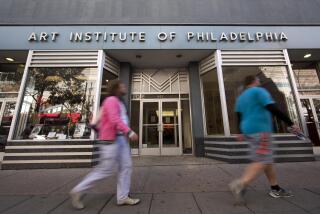When the Trade School Is No Class Act : Congress should act to curb abuse and fraud by some exploitative operators
- Share via
About 5% of the nation’s 15 million students in higher education attend trade schools. Most of these schools deliver what they promise: solid training and a leg up on employment in a vocation. But some for-profit schools are a persistent and costly problem for low-income students eager for vocational training--and for the federal government, which subsidizes their education.
Vocational schools, more businesses than institutions of higher learning, typically recruit students through print and broadcast ads that promise a lot: “We’ll train you for a high-paying career . . . “ in automotive repair, as a dental hygienist, cosmetologist or computer programmer. Some schools, however, deliver little in way of training and even less in terms of job placement, acting mainly as siphons for federal student loans.
Trade schools receive 25% of the $20 billion the U.S. government spends each year on student aid. Trade schools also account for 76% of all federal student loan defaults. In some cases, the schools enroll marginal students who do not finish. In others, the schools have poor instructors and inadequate equipment and produce students without good employment prospects. Either way, school operators pocket the federal aid. And sometimes they close up shop and leave students--and the government--holding the bag. To the tune of $3 billion each year.
In 1992, to stanch the tide of defaults on federal student loans, Congress required these for-profit trade schools to obtain at least 15% of their revenues from other sources, like co-payments from students or state, local or other federal programs. Congress hoped to ensure that taxpayers would pay only for schools that were good enough to attract buyers in a free market or those with aid funds from other loan programs that impose more stringent oversight or performance requirements on the schools. The so-called 85/15 rule was intended to give school owners incentive to offer quality education. This requirement, introduced by Rep. Maxine Waters (D-Los Angeles), is more than appropriate. But Congress has delayed its implementation for two years at the behest of the trade schools lobby.
When it returns from its August recess, Congress will again take up this issue. The House version of the proposed Education Appropriations Act, sadly, includes another one-year delay of the 85/15 rule. The better Senate version does not include the delay.
Trade school students, and taxpayer-funded federal student loans, should be protected from fraud and abuse. The 85/15 rule must not be delayed further.
More to Read
Sign up for Essential California
The most important California stories and recommendations in your inbox every morning.
You may occasionally receive promotional content from the Los Angeles Times.













